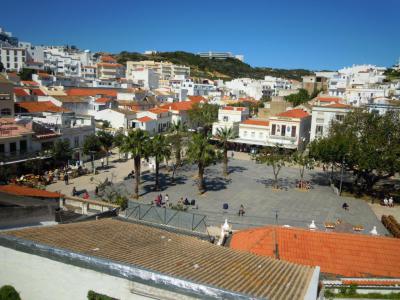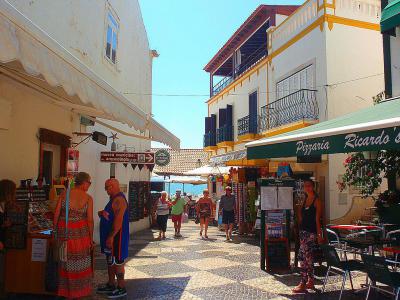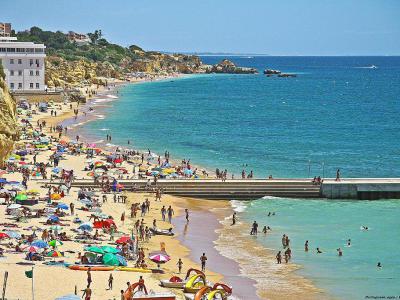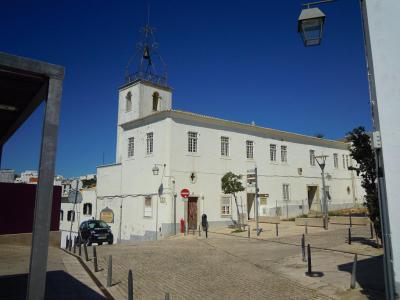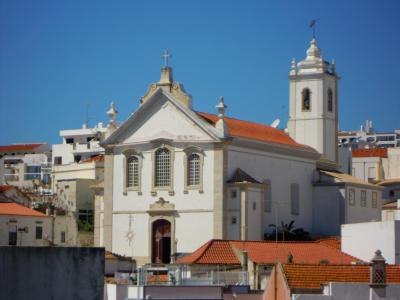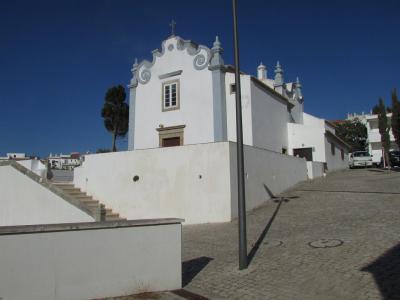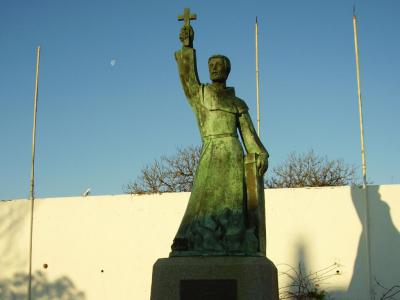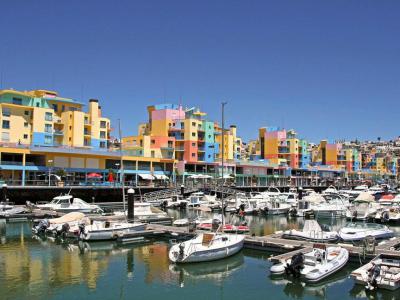
Albufeira Introduction Walking Tour (Self Guided), Albufeira
Settlements appeared in the area of Albufeira in pre-history. The fishing was good. The Romans came. They named the town Baltum. They gave it structure, administrative and architectural. Later the Romans left, but some architecture remains. The Byzantines made a brief appearance, followed by the Visigoths. The fish didn't play out until recently.
The Visigoths ruled until the Moors took up residence for an extended period. They named the town "al-Buhayra", meaning "the Lagoon", which gave the town today's name Albufeira. The Moors brought strong defenses, better agriculture and gardening. They too, liked fishing. Visigoth revenge came in the form of the Christian Reconquista in the 12th century.
Albufeira fell to the forces of Afonso III of Portugal in 1249. King Manuel I granted a Charter to the town of Albufeira in 1504. In 1755, Albufeira, like many Portuguese cities, was essentially destroyed by an earthquake and tsunami. The loss of life was catastrophic. Reconstruction began under the direction of Bishop Francisco de Avelar one year later.
The country was torn in the so-called "Liberal Wars" of the early 19th century. In the 20th century the fishing and export industries declined. By 1960 the town had become a magnet for tourism. Thousands of tourists a year visit Albufeira. Lots of fish are caught to serve the hungry tourists and there are those splendid beaches.
The beaches are a lot, but not all. Stroll from the Main Square to any place in the Old Town. Walk to the world class Marina, the Archeological Museum, shop on exotic Candido dos Reis Street, relax at Sir Harry's Bar, see the Bridge of Paderne, the Lighthouse of Albufeira, be inspired by the Neo-classical Parish Church, Saint Anne Church and the treasures they hold.
Albufeira is an ancient fishing village that has become a perfect holiday spot. It has six sandy beaches, including the famous Fisherman's Beach. Night life along The Strip is the liveliest in Portugal. Besides the water sports, the dining and the shopping, there is tranquility in its churches and parks. Find it all in Albufeira.
The Visigoths ruled until the Moors took up residence for an extended period. They named the town "al-Buhayra", meaning "the Lagoon", which gave the town today's name Albufeira. The Moors brought strong defenses, better agriculture and gardening. They too, liked fishing. Visigoth revenge came in the form of the Christian Reconquista in the 12th century.
Albufeira fell to the forces of Afonso III of Portugal in 1249. King Manuel I granted a Charter to the town of Albufeira in 1504. In 1755, Albufeira, like many Portuguese cities, was essentially destroyed by an earthquake and tsunami. The loss of life was catastrophic. Reconstruction began under the direction of Bishop Francisco de Avelar one year later.
The country was torn in the so-called "Liberal Wars" of the early 19th century. In the 20th century the fishing and export industries declined. By 1960 the town had become a magnet for tourism. Thousands of tourists a year visit Albufeira. Lots of fish are caught to serve the hungry tourists and there are those splendid beaches.
The beaches are a lot, but not all. Stroll from the Main Square to any place in the Old Town. Walk to the world class Marina, the Archeological Museum, shop on exotic Candido dos Reis Street, relax at Sir Harry's Bar, see the Bridge of Paderne, the Lighthouse of Albufeira, be inspired by the Neo-classical Parish Church, Saint Anne Church and the treasures they hold.
Albufeira is an ancient fishing village that has become a perfect holiday spot. It has six sandy beaches, including the famous Fisherman's Beach. Night life along The Strip is the liveliest in Portugal. Besides the water sports, the dining and the shopping, there is tranquility in its churches and parks. Find it all in Albufeira.
How it works: Download the app "GPSmyCity: Walks in 1K+ Cities" from Apple App Store or Google Play Store to your mobile phone or tablet. The app turns your mobile device into a personal tour guide and its built-in GPS navigation functions guide you from one tour stop to next. The app works offline, so no data plan is needed when traveling abroad.
Albufeira Introduction Walking Tour Map
Guide Name: Albufeira Introduction Walking Tour
Guide Location: Portugal » Albufeira (See other walking tours in Albufeira)
Guide Type: Self-guided Walking Tour (Sightseeing)
# of Attractions: 9
Tour Duration: 2 Hour(s)
Travel Distance: 2.5 Km or 1.6 Miles
Author: hollyg
Sight(s) Featured in This Guide:
Guide Location: Portugal » Albufeira (See other walking tours in Albufeira)
Guide Type: Self-guided Walking Tour (Sightseeing)
# of Attractions: 9
Tour Duration: 2 Hour(s)
Travel Distance: 2.5 Km or 1.6 Miles
Author: hollyg
Sight(s) Featured in This Guide:
- Old Town Square
- Cândido dos Reis Street
- Praia dos Pescadores (Fisherman's Beach)
- Archaeological Museum
- Clock Tower
- Igreja Matriz (Parish Church)
- Saint Anne Church
- San Vicente de Albufeira Statue
- Albufeira Marina
1) Old Town Square (must see)
Old Town Square is the true heart of old Albufeira. The square is a paved, tree-shaded public square of the old fishing village. It is surrounded by shops, and restaurants with open-air seating that offer excellent locations for people-watching. Street performers and musicians and mimes furnish entertainment every day.
Shops along the square offer a variety of goods, including beach toys, T-shirts, wines and Portuguese liqueurs. The free Art Gallery is in a former power station. It mainly features the work of Albufeira artist, Jose Barros. Cobblestone and mosaic patterned streets branch off from the square in every direction.
The square is lined with buildings with tile wall designs, iron balconies laden with flowers. Bar-hopping among the exotic pubs and music venues is a favorite sport at night. The square is a nexus point of the beach and the Old Town streets.
Shops along the square offer a variety of goods, including beach toys, T-shirts, wines and Portuguese liqueurs. The free Art Gallery is in a former power station. It mainly features the work of Albufeira artist, Jose Barros. Cobblestone and mosaic patterned streets branch off from the square in every direction.
The square is lined with buildings with tile wall designs, iron balconies laden with flowers. Bar-hopping among the exotic pubs and music venues is a favorite sport at night. The square is a nexus point of the beach and the Old Town streets.
2) Cândido dos Reis Street
Vice Admiral Carlos dos Reis would be amused to walk down the shopping street of Albufeira named for him. He was a leader of the Revolution of 1910 that overthrew the royal house and established the Portuguese Republic. On the night of October 3rd 1910, he proclaimed, "If there is one that fulfills his duty, this one will be me."
Candido dos Reis is a familiar street name in Portugal. The street is known locally as Bar Street. It is narrow, pedestrianized and paved with tiles. There are numerous small shops and stalls. A short walk from the main square there are more than a few branch streets but none as unique as the Candido dos Reis Street.
Exotic clothes and leather boutiques, original gift shops, kiosks with odds and ends and items not found in many other places make for a mini shopping safari. Many houses can still be seen with the traditional tiled facades. Palm trees and festive colored canopies offer shade.
Candido dos Reis is a familiar street name in Portugal. The street is known locally as Bar Street. It is narrow, pedestrianized and paved with tiles. There are numerous small shops and stalls. A short walk from the main square there are more than a few branch streets but none as unique as the Candido dos Reis Street.
Exotic clothes and leather boutiques, original gift shops, kiosks with odds and ends and items not found in many other places make for a mini shopping safari. Many houses can still be seen with the traditional tiled facades. Palm trees and festive colored canopies offer shade.
3) Praia dos Pescadores (Fisherman's Beach)
Fisherman's Beach is framed by the amphitheater of multi-colored houses in the west and by the pier in the east. Until fairly recently the beach was the domain of Albufeira's colorful fishing boats. The export market for fish has declined and only local markets are in operation. The fishing boats are now in the Albufeira Marina.
Access to the beach is via flights of steps and more easily from the large, paved, 25th of April Square on the western edge of the beach. Bordering the beach is a thriving tourist area of shops, bars and restaurants. Road traffic and parking is restricted in the neighborhood. No parking is available within 700 feet of the beach.
Fisherman's Beach is big. It is over 700 feet along the shore. At low tide it gains about 300 more feet in length. It is a part of the great reach of sand at the foot of Albufeira. The beaches neighboring Fisherman's Beach are Tunel, Inatel, and Alemaes. Fisherman's Beach lies between Tunel and Inatel.
Fisherman's Beach is a city beach. It is frequently crowded, especially in summer. The other beaches may afford more privacy.
Access to the beach is via flights of steps and more easily from the large, paved, 25th of April Square on the western edge of the beach. Bordering the beach is a thriving tourist area of shops, bars and restaurants. Road traffic and parking is restricted in the neighborhood. No parking is available within 700 feet of the beach.
Fisherman's Beach is big. It is over 700 feet along the shore. At low tide it gains about 300 more feet in length. It is a part of the great reach of sand at the foot of Albufeira. The beaches neighboring Fisherman's Beach are Tunel, Inatel, and Alemaes. Fisherman's Beach lies between Tunel and Inatel.
Fisherman's Beach is a city beach. It is frequently crowded, especially in summer. The other beaches may afford more privacy.
4) Archaeological Museum
Immediately inland from the beach in the Old Town of Albufeira is the Albufeira Municipal Archeology Museum. The building housing the museum does not look large from outside, but it is unexpectedly roomier inside.
The permanent collection consists of four distinct sections: Prehistory, Roman times, the Islamic era, and the early Modern Age, ending in the 17th century. Most of the exhibits were excavated by Father Jose Azevedo, an enthusiastic albeit amateur archeologist.
Father Azevedo collected items from sites close to home. He visited the Castle of Paderne, a Roman villa in Retorta, the necropolis of Morgado da Lameira and the Old Parish Church (Igreja Matriz). Among his treasures are an intact Roman mosaic and a Neolithic vase from 5000 BCE. The museum is part of the Algarve Museum Network.
In the two floors of the museum overlooking the sea are areas dedicated to study, conservation, restoration and storage. There is also a small library. Each exhibit is provided with information sheets printed in English, French, German, Spanish and of course, Portuguese. The museum is close to the Museum of Religious Art of Albufeira.
The permanent collection consists of four distinct sections: Prehistory, Roman times, the Islamic era, and the early Modern Age, ending in the 17th century. Most of the exhibits were excavated by Father Jose Azevedo, an enthusiastic albeit amateur archeologist.
Father Azevedo collected items from sites close to home. He visited the Castle of Paderne, a Roman villa in Retorta, the necropolis of Morgado da Lameira and the Old Parish Church (Igreja Matriz). Among his treasures are an intact Roman mosaic and a Neolithic vase from 5000 BCE. The museum is part of the Algarve Museum Network.
In the two floors of the museum overlooking the sea are areas dedicated to study, conservation, restoration and storage. There is also a small library. Each exhibit is provided with information sheets printed in English, French, German, Spanish and of course, Portuguese. The museum is close to the Museum of Religious Art of Albufeira.
5) Clock Tower (must see)
The Clock Tower of Albufeira, "Torre do Relogio" in Portuguese, is located on Bernadino de Sousa Street. It is considered to be the logo of Albufeira by the people of the town. The tower, once part of a fortified hospital complex, was built in the 18th century. It is square shaped with a clock and arched portals on each side.
The bell, which strikes every hour, is within a wrought-iron framework. At night the framework is outlined with lights; an impressive sight. The view of the Atlantic Ocean seen from the towers is uncluttered and amazing. Nearby the old hospital complex is a cordoned off area enclosing the remains of two 12th century Islamic houses.
The tower and bell can be seen from almost any point in the Old Town. It makes for a great picture and a convenient meeting place ("Meet me under the Tower with the Bell.", locals would say).
Tip:
Outside the clock tower, you can also see the interesting remains of two Moorish houses that date back to the 12th-13th centuries. There is no direct access due to the location being cordoned off, but the remains are still clearly visible.
The bell, which strikes every hour, is within a wrought-iron framework. At night the framework is outlined with lights; an impressive sight. The view of the Atlantic Ocean seen from the towers is uncluttered and amazing. Nearby the old hospital complex is a cordoned off area enclosing the remains of two 12th century Islamic houses.
The tower and bell can be seen from almost any point in the Old Town. It makes for a great picture and a convenient meeting place ("Meet me under the Tower with the Bell.", locals would say).
Tip:
Outside the clock tower, you can also see the interesting remains of two Moorish houses that date back to the 12th-13th centuries. There is no direct access due to the location being cordoned off, but the remains are still clearly visible.
6) Igreja Matriz (Parish Church)
The church of the patron saint of Albufeira is Our Lady of the Conception, also known as Parish Church. It is on New Church Street. It was built in 1782 to replace the church destroyed by the hellish earthquake of 1755. The old church was a reinvented mosque. The New Church was consecrated in 1800 by Bishop Gomes de Avelar.
The church is a Neoclassic structure with one nave, four side chapels or altars, a choir, a baptismal, two pulpits and side halls. A painting by Albufeira painter Samora Barros is a rococo rendering of Our Lady of the Conception in a niche. In the presbytery are two paintings by Alvaro Mota and by Sousa showing scenes from the life and martyrdom of St. Vincent.
The chapels are dedicated to Saints Peter and Louis, Our Lady of Fatima and The Sacred Heart of Jesus. In 1868 the altar was gilded. There is a statue of the Immaculate Conception over the altar. The bell tower dates from 1869 and it is 92 feet high. The carillon has eight bells tuned to F major. A spiral staircase leads to the top.
The church is a Neoclassic structure with one nave, four side chapels or altars, a choir, a baptismal, two pulpits and side halls. A painting by Albufeira painter Samora Barros is a rococo rendering of Our Lady of the Conception in a niche. In the presbytery are two paintings by Alvaro Mota and by Sousa showing scenes from the life and martyrdom of St. Vincent.
The chapels are dedicated to Saints Peter and Louis, Our Lady of Fatima and The Sacred Heart of Jesus. In 1868 the altar was gilded. There is a statue of the Immaculate Conception over the altar. The bell tower dates from 1869 and it is 92 feet high. The carillon has eight bells tuned to F major. A spiral staircase leads to the top.
7) Saint Anne Church (must see)
Easy to locate in Jacinto D'Ayet Square in the Old Town by its stunning whitewashed facade, is the 18th century church of Saint Anne. Like many other buildings in Albufeira, the original Church of Saint Anne was destroyed completely in the earthquake of 1755. The Church is dedicated to Saint Anne, the maternal grandmother of Jesus.
The baroque altarpiece has a statue of Saint Anne in the center. At the right side there are statues of St. Joseph and the child Jesus. On the left side is Anne's husband, St. Joaquin. The piece is painted blue with gilding. This is probably the work of sculptors Francisco Xavier Guedelha and Joao Baptista.
This is a one nave church with three chapels. Other carved statues in the church include one of Christ Crucified. The baroque wooden pulpit is pointed in gold. The church is very close to the Vila Recife Hotel and the Parish Church. Each year on the 14th of August Images of Mary and Child Jesus from the church are paraded in a boat.
The baroque altarpiece has a statue of Saint Anne in the center. At the right side there are statues of St. Joseph and the child Jesus. On the left side is Anne's husband, St. Joaquin. The piece is painted blue with gilding. This is probably the work of sculptors Francisco Xavier Guedelha and Joao Baptista.
This is a one nave church with three chapels. Other carved statues in the church include one of Christ Crucified. The baroque wooden pulpit is pointed in gold. The church is very close to the Vila Recife Hotel and the Parish Church. Each year on the 14th of August Images of Mary and Child Jesus from the church are paraded in a boat.
8) San Vicente de Albufeira Statue
Sharing the Jacinto D'Ayet Square with the Church of Saint Anne is the statue of Saint Vicente of Albufeira. Vicente was a Jesuit missionary who traveled to far-off Japan in the 16th century. His mission was to convert souls to Christianity. Japanese authorities were touchy about foreigners preaching religion. He was martyred by fire.
The statue of the Saint is bronze on a stone pedestal. Vicente is dressed in his priestly garb, holding a crucifix aloft in his right hand. Depending on the season and location of the viewer, the sun can be observed shining through the crucifix. The resulting optical effect showing the statue holding up a pure white light. Vicente would have liked it.
Saint Vicente was born in Albufeira in 1590. At that time, Albufeira was no more than a castle with a small village. He studied in Lisbon. After his parents died he began to travel. He visited Spain, Mexico, the Philippines and Japan. He died on September 3, 1623. September 3 is observed as his special day in Albufeira.
The statue of the Saint is bronze on a stone pedestal. Vicente is dressed in his priestly garb, holding a crucifix aloft in his right hand. Depending on the season and location of the viewer, the sun can be observed shining through the crucifix. The resulting optical effect showing the statue holding up a pure white light. Vicente would have liked it.
Saint Vicente was born in Albufeira in 1590. At that time, Albufeira was no more than a castle with a small village. He studied in Lisbon. After his parents died he began to travel. He visited Spain, Mexico, the Philippines and Japan. He died on September 3, 1623. September 3 is observed as his special day in Albufeira.
9) Albufeira Marina (must see)
The marina at Albufeira is considered to be the safest and best sheltered marina in all of Portugal. The marina is a high-end tourist complex including hotels, restaurants, bars, the marina nautical club and a recreation and leisure center.
It is much more than a Yacht club. It has 475 moorings, yes. It also has 590 rooms in three hotels, including 75 apartments in a four-star apart-hotel. There is a 220 unit tourist complex, and 133 family residences. Three tourist villages provide 389 apartments. There are upscale stores and a Naval Club.
The Marina is a perfect place for a stroll among sea-going vessels of every type and the rainbow colored apartments along the waterfront. Activities beside Fishermen-watching include: Jet Skis, Rocket boats, Para-sailing, Dolphin watching, yacht charters, all sorts of water sports and sunset cruises.
The marina is easily accessible at the end of the motorway from Lisbon and only 40 kilometers from Faro airport.
It is much more than a Yacht club. It has 475 moorings, yes. It also has 590 rooms in three hotels, including 75 apartments in a four-star apart-hotel. There is a 220 unit tourist complex, and 133 family residences. Three tourist villages provide 389 apartments. There are upscale stores and a Naval Club.
The Marina is a perfect place for a stroll among sea-going vessels of every type and the rainbow colored apartments along the waterfront. Activities beside Fishermen-watching include: Jet Skis, Rocket boats, Para-sailing, Dolphin watching, yacht charters, all sorts of water sports and sunset cruises.
The marina is easily accessible at the end of the motorway from Lisbon and only 40 kilometers from Faro airport.
The Most Popular Cities
/ view all
